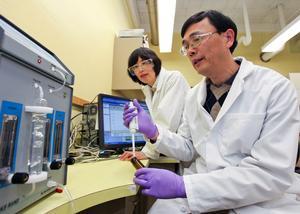
|
Findings published in Proceedings of the National Academy of Sciences by Oak Ridge National Laboratory's Liyuan Liang and Baohua Gu help explain previously reported seemingly contradictory findings.
[ORNL photo by Jason Richards] |
In a paper published in the Proceedings of the National Academy of Sciences, a team led by Gu reports that compounds from the decay of organic matter in aquatic settings affect mercury cycling. Low concentrations of these compounds can chemically reduce mercury, but as those concentrations increase, that reaction is greatly inhibited. They performed their experiments by simulating conditions found in nature.
"This study demonstrates that in anoxic sediments and water, organic matter is not only capable of reducing mercury, but also binding to mercury," said co-author Liyuan Liang. "This binding could make mercury less available to microorganisms for making methylmercury."
The authors also noted that their paper offers a mechanism that helps explain the seemingly contradictory reports on the interaction of organic matter and mercury in nature.
Gu and Liang hope this newly gained knowledge will play a role in helping to understand how mercury cycles in aquatic and sediment environments and help in informed decision-making for mercury-impacted sites around the nation.
"Our long-term goal is to understand the mechanisms controlling the production of methylmercury in the environment, " Liang said. "This understanding could lead to ways to reduce levels of mercury in fish as this is a global problem of enormous significance."
Mercury is distributed around the globe mainly through the burning of coal, industrial uses and through natural processes such as volcano eruptions. Various forms of mercury are widely found in sediments and water.
This research benefits from ORNL's expertise in field-to-laboratory geochemistry and microbiology, computational modeling and simulation, world-class neutron sources and high-performance computing.



